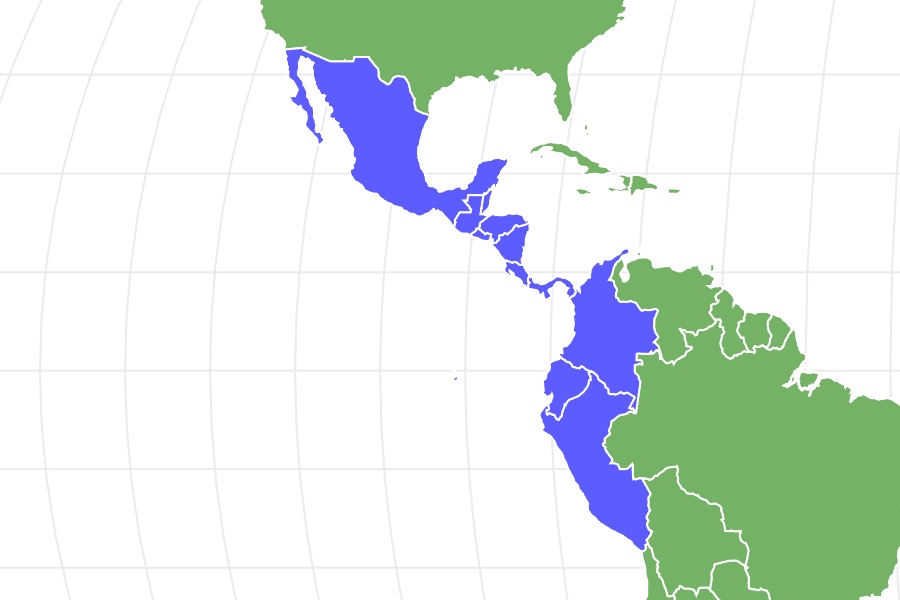Eyelash Viper
Bothriechis schlegelii
While the eyelash viper can be a pet, be cautious – they are extremely venomous!
Advertisement
Eyelash Viper Scientific Classification
- Kingdom
- Animalia
- Phylum
- Chordata
- Class
- Reptilia
- Order
- Squamata
- Family
- Viperidae
- Genus
- Bothriechis
- Scientific Name
- Bothriechis schlegelii
Read our Complete Guide to Classification of Animals.
Eyelash Viper Conservation Status
Eyelash Viper Facts
- Prey
- Small birds, lizards, frogs, small rodents.
- Name Of Young
- Neonates, babies, snakelets
- Group Behavior
- Solitary
- Solitary except during mating season
- Fun Fact
- While the eyelash viper can be a pet, be cautious – they are extremely venomous!
- Litter Size
- 2-20
- Diet for this Fish
- Carnivore
- Lifestyle
- Nocturnal
- Common Name
- Eyelash viper, eyelash pit viper, eyelash palm viper, eyelash snake, eyelash lancehead, eyelash mountain viper, horned palm viper
View all of the Eyelash Viper images!
The eyelash viper has a distinct set of scales above their eyes that look like bold eyelashes.
The eyelash viper appears in many different colors, making it attractive to the pet trade. It gives birth to live young, carrying along the eggs for half of the year before they are born. Their lifespan is at least 10 years. Scientists have yet to determine a worldwide population.

5 Amazing Eyelash Viper Facts!
- Since they can be bright shades of yellow and often live in banana plantations, they’ve accidentally been transported between countries with exported bananas
- The eyelash viper is known for striking faster than almost any other snake in the world.
- The snake is polygynous, taking more than one partner in a breeding season.
- Baby eyelash vipers are called snakelets, and they can live independently from their parents as early as their first day of life.
- There is no specific mating season; these snakes will mate throughout the year, carrying their eggs internally for six months before giving birth to live young.

The eyelash viper can be colored green, yellow, brown, red, pink, or blue.
©Tobias Hauke/Shutterstock.com
Scientific Name
The scientific name of this snake is Bothriechis schlegelii, which is meant to honor a German ornithologist and herpetologist named Hermann Schlegel.
The eyelash viper has many other names, including the eyelash pit viper, eyelash palm viper, eyelash lancehead, eyelash snake, horned palm viper, and eyelash mountain viper.
Its class is Reptilia, and it is part of the Viperidae family.
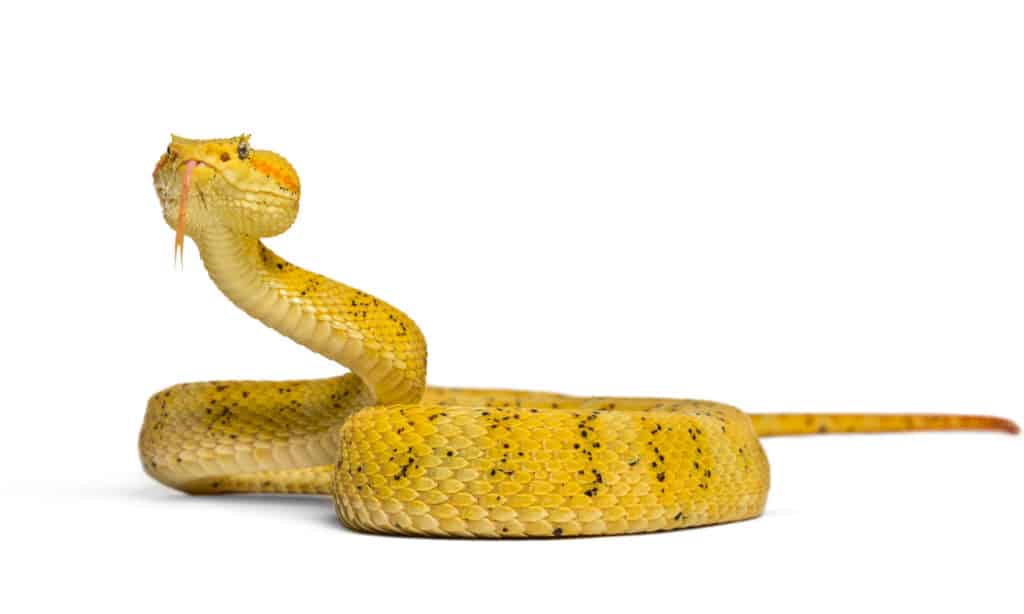
The eyelash viper’s scientific name honors German ornithologist and herpetologist Hermann Schlegel.
©Eric Isselee/Shutterstock.com
Evolution and Origins
The eyelash viper belongs to the Viperidae family, which fossil evidence dates back to originating in the lower Miocene 23.03 million years to 15.97 million years ago.
This viper has evolved by adapting to its environment in several ways. Its scales are rough and keeled (a ridge runs down the center), which helps it traverse the branches of its arboreal habitats. A strong prehensile tail also assists it to stay up and move about in the trees. The extended scales above its eye that give this species its common name are likely an adaptation that supplies the snake with additional camouflage as it has the effect of appearing less like a typical snake’s head, useful when ambushing prey and evading predators.
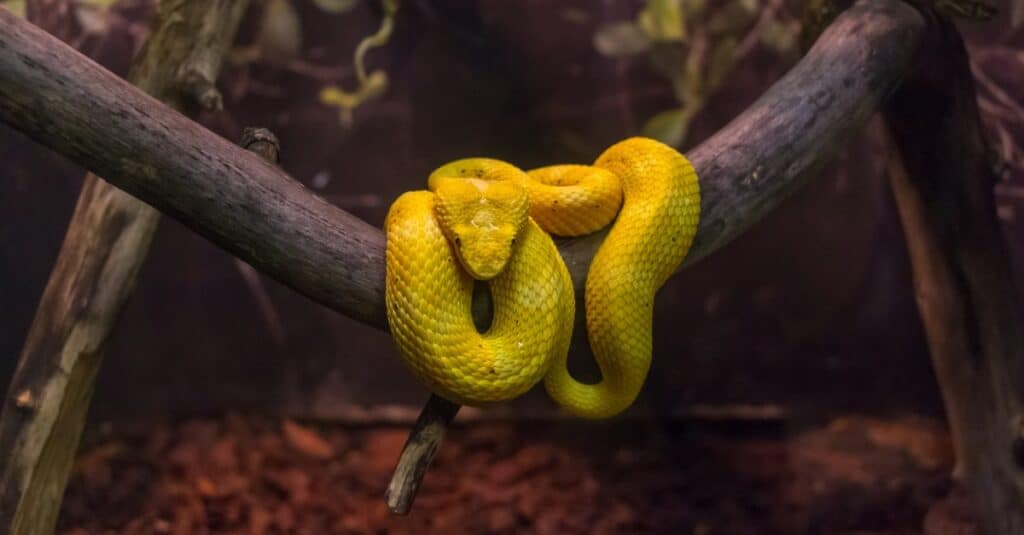
The eyelash viper’s rough scales help it stay up in branches in its arboreal habitats.
©iStock.com/Maria Khomiakova
Appearance
One of the big reasons that the snake is so popular is the beautiful range of colors in which it is found. They are typically found in green, brown, yellow, or red, though they can also be found in bold colors like pink or even blue. They have subtle and sparse speckles of brown or black dots along their entire body.
It would be remiss to not mention the main reason they are called the eyelash viper. With superciliary scales above their eyes, their camouflage looks much like separate pieces of grass and foliage. Plus, like all vipers, they have large needle-like fangs that fold onto the roof of their mouth when they are not going after prey. Between the eyes and the nostrils, they have pits that sense the heat of possible meals as they go by.
How to identify an eyelash viper:
- Green, brown, yellow, red, pink, or blue body.
- Lightly speckled with brown or black dots.
- Superciliary scales above their eyes that look like eyelashes.
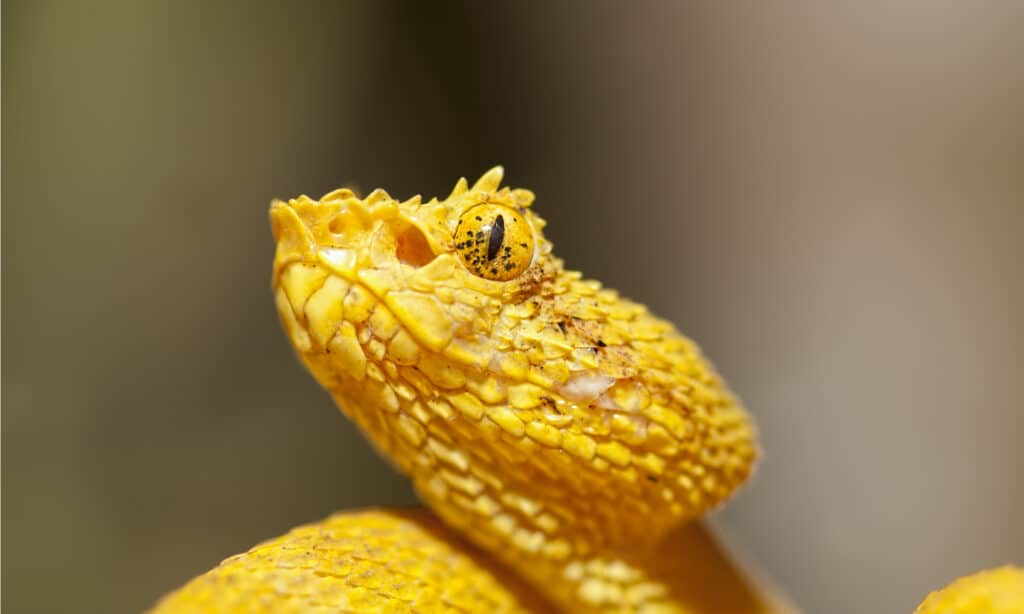
The eyelash viper is known for its distinct set of scales that look like eyelashes.
©Roy H./Shutterstock.com
Behavior
Typically, there is no outright aggression of the snake toward humans. In fact, the vibrant colors of this snake have led it to become a highly desired pet among consumers. The venom of the eyelash viper is incredibly dangerous, though there are some cases of a “dry bite,” which means that the snake doesn’t get the chance to release venom.
Venom: How Dangerous Are Eyelash Vipers?
Like all vipers, the snake poses a significant threat to anyone nearby. They are highly venomous, and they are known for their incredibly fast strike. They aren’t aggressive, as they see larger animals as threats, not prey. And, eyelash vipers prefer to use their bite as a way to catch their prey. However, their venom is strong enough to kill a human in some circumstances.
If an eyelash viper bites you, you need to treat it the same way that you would for any pit viper. You may not even know that you’ve been bitten right away because they don’t always leave a mark. Trouble breathing, pain, bruising, changes in heart rate, and numbness are all common symptoms. You may even have a minty, rubbery, or metallic taste in the mouth. The actual risk of death and severe symptoms depends on how much venom is released and your current health risks. If you don’t experience symptoms within 8 hours, you’ll need to watch out for the next two weeks. Luckily, about 25% of bites are dry and nothing happens. Seek out medical attention if you’re unsure.
Even if the pit viper is dead, it can still strike and release venom for up to 90 minutes, so be careful around the head.

Eyelash vipers are highly venomous but are not aggressive.
©Fabrice Mieville/Shutterstock.com
Habitat
The primary home of the eyelash viper is Central and South America, though it has been found as far north as southern Mexico and as far south as the lowland areas of Peru, Ecuador, and Costa Rica. They prefer a humid and tropical climate, specifically placed in lower altitudes.
With dense foliage, the viper can conceal itself within its natural habitat to protect it from being seen by predators. Yellow eyelash vipers often live in or near banana plantations. They blend into their surroundings easily and ambush prey, such as bats. Red eyelash vipers tend to be in environments where red-colored bromeliads grow, allowing them to feed on the small amphibians in the plants’ locations. No matter what location the eyelash viper is found, they need to have a nearby water source to stay hydrated. Some studies show that this snake can be found in shaded ravines as well.
The eyelash viper is arboreal, which means it likes to live in trees. Though it doesn’t typically migrate, it will go to the same spots each year that birds migrate to.
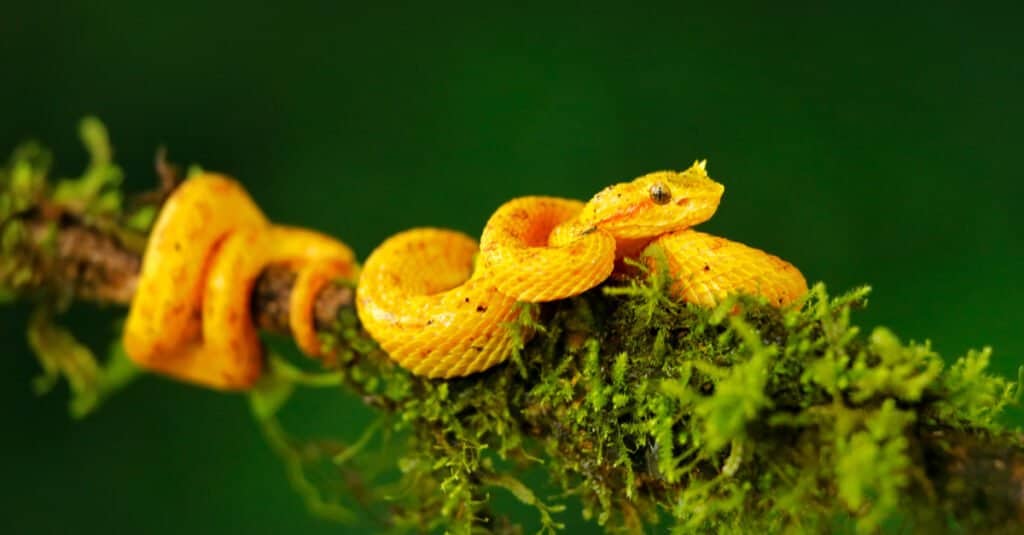
The eyelash viper lives among the trees.
©Ondrej Prosicky/Shutterstock.com
Diet
The typical diet of the eyelash viper consists of small rodents, frogs, lizards, and small birds.
The eyelash viper is an ambush hunter, waiting for their prey to come by as they lay in wait. Since migratory birds tend to be on their preferred menu, these reptiles will sometimes go to the same area every spring as they expect their prey to return.
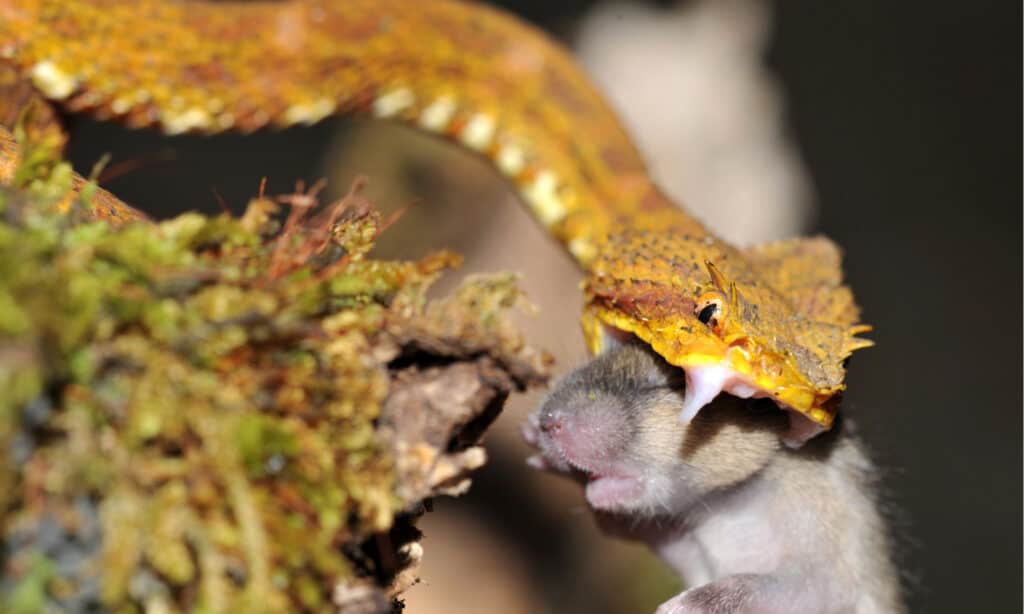
An eyelash viper shows how it strikes a mouse, one of the rodents included in its diet.
©worldswildlifewonders/Shutterstock.com
Predators and Threats
Natural predators of this snake species include badgers, cats, foxes, and hedgehogs.
The eyelash viper is at risk from humans due to habitat loss caused by deforestation and the clearing of land to use for livestock ranching and for banana plantations, particularly in Guatemala and Mexico. The snake has shown it is able to survive in some habitats after modifications.

Eyelash vipers, here in snakelet form, are at threat from deforestation of its habitats.
©Alexey Stiop/Shutterstock.com
Population and Conservation
While there is not a specific number of eyelash vipers noted, their population is steady.
The IUCN Red List considers them to be Least Concern, though they could progressively lose access to their natural habitat as deforestation and urbanization progress.
Similar Animals
View all 117 animals that start with EEyelash Viper FAQs (Frequently Asked Questions)
What is an eyelash viper?
An eyelash viper is a highly venomous snake that can be found in many beautiful colors, including pink, blue, yellow, red, brown, and green. This type of pit viper primarily lives in Central and South America, though it is sometimes kept as a pet. Its most notable feature is the bristly brow that looks like a pair of eyelashes, meant to help them conceal themselves while hunting.
Why is it called an eyelash viper?
Bristly scales above the eyes have earned this snake the name “eyelash viper.” Local myths say that this snake can wink at its victim after it strikes, but there’s no scientific evidence to back up this claim.
How venomous is an eyelash viper?
There are few snakes that are as venomous as the eyelash viper in Costa Rica.
Are eyelash viper bites fatal?
In some cases, a bite is fatal. With the hemotoxic and neurotoxic properties of the venom, it can cause severe damage to the cardiovascular system and the central nervous system.
Are eyelash vipers good pets?
While the eyelash viper can be a pet, be cautious – they are extremely venomous.
Where do eyelash vipers live?
The primary locations of this snake are Central America and South America.
What does an eyelash viper eat?
The typical diet of the eyelash viper consists of small rodents, frogs, lizards, and small birds.
How do eyelash vipers hunt?
The eyelash viper is an ambush hunter, waiting for their prey to come by as they lay in wait. Since migratory birds tend to be on their preferred menu, these reptiles will sometimes go to the same area every spring as they expect their prey to return.
Thank you for reading! Have some feedback for us? Contact the AZ Animals editorial team.
Sources
- Wikipedia / Accessed March 1, 2022
- Animalia / Accessed March 1, 2022
- John Hopkins Medicine / Accessed March 1, 2022
- University of Michigan Health / Accessed March 1, 2022
- Everything Reptiles / Accessed March 1, 2022
- Smithsonian's National Zoo & Conservation Biology Institute / Accessed March 1, 2022
- The Tico Times / Accessed March 1, 2022
- Snake Facts / Accessed March 1, 2022

